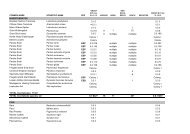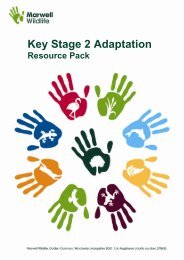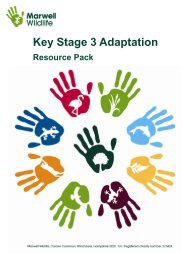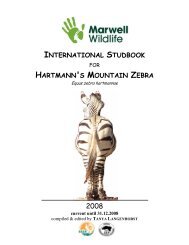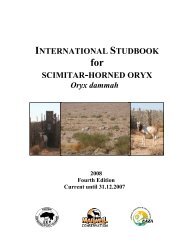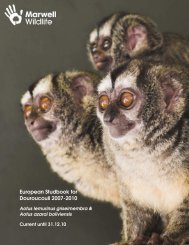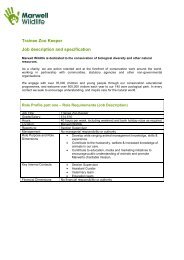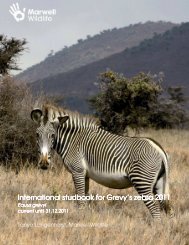Hartmann's mountain zebra studbook 2011 - Marwell Zoo
Hartmann's mountain zebra studbook 2011 - Marwell Zoo
Hartmann's mountain zebra studbook 2011 - Marwell Zoo
Create successful ePaper yourself
Turn your PDF publications into a flip-book with our unique Google optimized e-Paper software.
ecapture estimate is so high (74%) relative to the ‘source’ numbers. This suggests that the northern<br />
area of Gondwana Cañon Park is a key area for the wider population. Presumably, the reason for this<br />
is the fact that this area contains a reliable, abundant water supply plus a good food supply. The<br />
animals are generally in good condition, even in the late dry season, so do not appear to have<br />
reached carrying capacity, at least in years with average rainfall. The movements between FRCNP<br />
and GCP in the dry season must be driven by some, as yet unknown, relationship with the dry season<br />
water supply in the National Park, presumably the remaining pools in Fish River itself, and the relative<br />
availability of food there.<br />
NamibRand Nature Reserve (NRNR)<br />
We attempted a similar mark-recapture estimate in the northern part of the NRNR, an area of about<br />
30,000 ha, using camera traps at 5 water holes. Unfortunately, equipment failures meant that cameras<br />
were not always operating simultaneously and so a simple analysis, pooling data from all the water<br />
holes, could not be used. Instead, I adopted an approach starting with separate estimates for the most<br />
commonly used water holes. The largest numbers were at Moringa water, the most north-easterly<br />
water source where mark and recapture periods of 48 hours each in October-November yielded an<br />
estimate of 158+/-12 <strong>mountain</strong> <strong>zebra</strong>. The next highest numbers, from slightly different sampling<br />
dates, were 87+/-13 and 77+/-17 at the two other main water holes. These estimates cannot be<br />
simply summed up because of overlap in use, so I quantified the overlap and corrected the numbers<br />
using the proportion of animals that occurred exclusively at each water hole during the sampling<br />
period. The adjusted values were then summed giving an estimate of 235 <strong>mountain</strong> <strong>zebra</strong> for these<br />
three key waterholes. A simple average of the standard errors for the three sites gave an estimate of<br />
235+/-14. This value is higher than that from 2010 but the procedure was simpler in that year and is<br />
not strictly comparable. The <strong>2011</strong> value is based on 196 individuals actually identified at the three<br />
water holes, 83% of the estimate, and despite the methodological difficulties is probably quite realistic.<br />
The other two water holes sampled in the north-west of NRNR (one at Sossusvlei Desert Lodge) had<br />
fewer <strong>mountain</strong> <strong>zebra</strong> visiting and so a formal estimate could not be carried out. However, 24<br />
individuals were identified over the last three months of the year, bringing the total for the northern<br />
area to about 259. There is a high level of connectivity between the two water holes in the north-east<br />
but none with the three main water holes sampled in the north-west. We believe that the <strong>mountain</strong><br />
<strong>zebra</strong> living in the north-west are probably the southern edge of a sub-population that extends<br />
northwards beyond the boundaries of NamibRand and I am currently analysing the first results from<br />
camera trapping outside the northern boundary in a neighbouring property called Geluk. Although this<br />
work is at an early stage, 35 new animals have been found (and added to the ID library) and 5 animals<br />
(two in a breeding group and three bachelors) that had previously been seen inside NRNR have been<br />
identified. These are thus the first known individuals who definitely move in and out of the reserve.<br />
There were thus about 259 <strong>mountain</strong> <strong>zebra</strong> in the 30,000 ha northern part of NamibRand Nature<br />
Reserve (235 from the 3 north-eastern water holes plus 24 known at Sossusvlei Desert Lodge) giving<br />
a density of 0.86/km 2 . These were the numbers present in part of the Reserve out of a source<br />
population of over 424 (the numbers of individuals identified or otherwise known to have been present<br />
in <strong>2011</strong>) and so represent about 61% of the wider population. From the point of view of population<br />
management this is good news for the reserve because the chance of a larger population remaining<br />
genetically viable is higher. However, it also means that the conservation of the wider population, in<br />
the Nubib <strong>mountain</strong>s and beyond, is dependent on actions beyond the boundaries of the Reserve and<br />
thus on wider co-operation between landowners.<br />
AII





